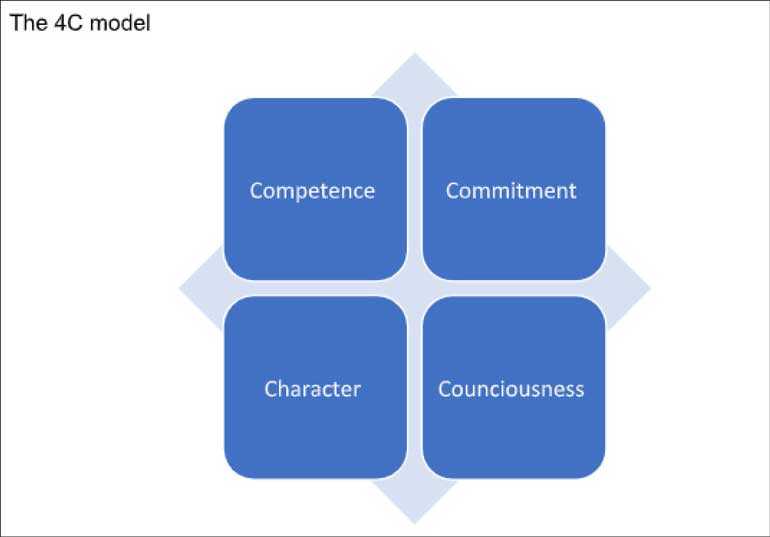Friday Nov 21, 2025
Friday Nov 21, 2025
Thursday, 2 April 2020 00:00 - - {{hitsCtrl.values.hits}}


Exploring a leadership model apt during times of crisis as an operating
manual for leaders
post COVID-19
Several inadvertent sit-downs with a wise oak quite recently, made a thalassophile such as I realise a treasured life lesson: How much sailors know about the nature of storms. What it takes to endure the  fury of Mother Nature, the inner resolve it demands to captain a ship, pilot it to safety and berth her at the port of call with the lives, livelihood and spirits of your crew intact.
fury of Mother Nature, the inner resolve it demands to captain a ship, pilot it to safety and berth her at the port of call with the lives, livelihood and spirits of your crew intact.
For this exhilarating feat, the capabilities of the ship’s steering apparatus, the competence of the seafarers of different ranks, coordination of on-board operations and fitting management strategies – both technical and motivational – are tested to their very depths and sometimes even to the brink of tipping point. If they are candid beyond the point of propriety, the captain might even admit to you that the task is as challenging, as it is enjoyable; a test of will, and a brutal man vs wild contest.
Features of a tropical storm
All storms, be it metaphoric or literal have similar characteristics. Any crisis is characterised by two traits – unpredictability and uncertainty, with survival boiling down to one thing; endurance skill.
In theory a tropical storm develops during the warm seasons when pressure from the evaporating seas combines with cool air from the atmosphere. With the combination of low and high pressure systems, clouds begin to form and rise from the sea into the atmosphere, creating the characteristic spiral shape of the tropical storm. Tropical storms can develop very quickly as evaporated water pushes wind to the surface of the ocean, speeding up evaporation and intensity. Once the storm reaches wind speeds of 38 mph, the storm is officially a tropical cyclone, according to the Caribbean Institute for Meteorology and Hydrology.
By now the similarities with the COVID-19 storm are undeniable. March/April for Sri Lanka is celebratory, a time for warm smiles and group hugs and papare bands. The MACRO economic conditions coupled with your own SWOT can sometimes combine to create a cocktail of pressures unique to your situation and cook up quite the tempest ranging from ‘a storm in a tea cup’ or one that will create lasting ripples like destructive tidal waves.
COVID-19 developed, one might say, too quickly for a fitting response, unanticipated by the stretch of imagination of any Business Continuity Planning expert or Contingency Planning Strategist. There was no predicting this. The time capsule within which COVID-19 went from an endemic to epidemic and then global pandemic is a matter of weeks. Yet, as recent as 2017, TIME magazine’s title caption read, “Warning: the world is not ready for another pandemic”. In reality, this was a pandemic, well before the World Health Organisation officially declared it one on 11 March.
As of 26 March, there were more than 470,000 confirmed cases of COVID-19 around the world and more than 20,000 deaths, across every continent save and except Antarctica. Whether or not we should have seen it coming is a topic for another day.
On the award-winning science site, BBC Future, Bryan Walsh most profoundly writes: “Over the past 15 years, there has been no shortage of articles and white papers issuing dire warnings that a global pandemic involving a new respiratory disease was only a matter of time. On BBC Future in 2018, we reported that experts believed a flu pandemic was only a matter of time and that there could be millions of undiscovered viruses in the world, with one expert telling us, ‘I think the chances that the next pandemic will be caused by a novel virus are quite good.’ In 2019, US President Donald Trump’s Department of Health and Human Services carried out a pandemic exercise named ‘Crimson Contagion,’ which imagined a flu pandemic starting in China and spreading around the world. The simulation predicted that 586,000 people would die in the US alone. If the most pessimistic estimates about Covid-19 come true, the far better named ‘Crimson Contagion’ will seem like a day in the park.”
The context is clear. We are at war. Let’s be done with sugar coating it and get to work.
Head in the right game
Be assured not even the most creative imagination and macabre plot ever stretched any of our thinking to bring to the forefront of our mind a situation that posed such a threat to self, those nearest and dearest, your crew, customers, stakeholders, suppliers and business partners, governmental and financial systems. A virus that runs rapidly through every tapestry of our social fabric faster than any locomotive seemed like something out of science fiction. You are not alone in this thinking but it is best to get out of that initial shock, if any, fast.
However, if you are not already on a video link with your cross-border A team in different time zones on topics, including but certainly not limited to, mitigating disruption in this times of crisis, stabilising supply chain impact, considering the strength of available IT infrastructure, fortification of staff well-being, critical responses and designing fitting communication protocols, and instead are preoccupied by the melodramatics on social media then, you are not in the right game.
As Mark Nevins, the senior leadership strategist so eloquently writes; “The reality of life post-COVID-19 has not fully sunk in yet, and its consequences for our businesses, organisations, economy, and society will play out over the rest of 2020 and beyond. Right now, we really need sober, smart, values-driven, and focused leadership. Remember the old adage, ‘Crisis does not build character, it reveals it.’
“Eighteen months ago, my friend John Hillen and I published a book on leadership titled ‘What Happens Now?’ The book’s core argument is that leaders, even (and especially) highly successful ones, must reinvent and change themselves or risk being outrun by their businesses. No matter how effective you were yesterday, you will find that today and tomorrow are likely to make new and different demands on you as a leader. If you fail to reinvent and adapt, you and your organisation will stall and fail.”
Let it not be too little, too late
The beckoning need is not to be preoccupied and dwell on yesterday’s developments, but to look ahead and plan for a more secure tomorrow. By all means, be informed and move on. Survival is now, more than ever, a matter of speed. Any agenda to gain popularity as the harbinger of good news or bad, needs to be shelved.
MD & Co-founder, iXceed Solutions Yogita Tulsiani in a delicate piece published in Economic Times, India reveals: “Leaders should be the embodiment of deliberate calm and bounded optimism as the threat knocks at their doors. May this be true for you, may this be true of your team. Because much depends on it.
Here are the five prudent responses she recommends that every leader in any industry and sector should consider in the face of the growing crisis –
1. A network of teams: Responding to the crisis
In typical emergencies, a company can ensure the maximum result and minimal risk by sticking to a command-and-control structure. However, during a pandemic, the same response infrastructure will prove highly ineffective. Leaders barely have the understanding or familiarity of the crisis.
It is impractical for one or a small group of company executives to collect, and process all the information regarding the imminent threat of COVID-19 infection in their area or among their staff. Leaders can mobilise the solution by appointing response-leadership teams, action teams, internal and external communications teams, colleague outreach personnel and tech management teams for the effective collection, comparison, verification and circulation of data and memorandum within the company.
Organising a network of teams can help avoid the chaos that often results from the panic. A network of teams consists of multiple groups working towards a singular goal, with clear compartmentalisation of their responsibilities.
2. Be flexible: Flexible hierarchy and responsibility to fight the COVID-19 crisis
Traditional hierarchical structures of an organisation maybe ineffective in containing or managing crises. Senior executives need to be ready to confer greater responsibility and liberty in decision-making decisions to their network of teams, as team members have the updated information necessary to direct the crisis response of an organisation.
It is, of course, the responsibility of senior management to ensure that they offer responsibility to the correct people, who can make correct crises-responses. Making the right decisions at the right time is crucial during an unplanned emergency. At the very onset (of a crisis), senior leaders should make the effort to direct the response to the crisis.
With the evolution of a crisis, team leaders may need to appoint more decision-makers from the network of teams or replace the ones affected by the situation. Having a plan to appoint interim leaders from among the network of teams during an emergency can build confidence among the employees and promote a deliberate calm that can ensure operational integrity irrespective of location.
3. Bounded optimism: Balance confidence with data
Bounded optimism is another term we come across in the field of crises management. It is the result of combining reality with optimism and confidence. Exhibiting excessive confidence despite the dire situation can cause leaders to lose credibility and trustworthiness.
Bounded optimism comes into action when the company leaders show confidence that stems from research data, demographics and tactical plans or policies that can address the crisis. Only when leaders project confidence as a result of collecting the latest data and recognising the threat, does optimism become beneficial to the team and senior executives.
4. Collect, assess and anticipate: Make information-based decisions
Making decisions is a big part of the job of any senior executive. But as the traditional hierarchy proves inept to handle immediate crises, waiting for a full set of facts to emerge is not a luxury they can afford! They need to authorise team leaders to act based on the data available to them at that time. Since an emergency like the current crisis can involve innumerable uncertainties and surprises, failing to act sooner, rather than later, can cost a company heavily.
Right decision making involves the power to assess the current situation and to anticipate the impacts across multiple layers. Although leaders cannot afford to wait indefinitely for new data to make decisions, they need to be ready to proactively collate data in real time to determine the traits of the crisis. This is the only way to understand how their responses work.
5. Show your human side: Empathise
The final facet of those entrusted with responsibility is to deal with every human tragedy with empathy. It may be impractical for senior executives to reach out to individual employees to extend emotional support, but that is exactly what is most necessary during these trying times. Questions like “Will this hurt me? Will I fall sick? Is my family in danger?” will only grow in intensity and frequency. And no matter how many times an employee expresses their concerns to team leaders, their concerns deserve honest responses, and due empathy.
It is not good practice to redirect them to the legal team or communications team. It is time for leaders to show their human side. Even a simple encouraging email each day, sharing precautionary tips and managing location independent infrastructure are all part of a true leader’s role.
Expert opinion of Prof. Madurasinghe
I had the good fortune of recording the expert opinion of Prof. Dr Lakshman Madurasinghe, Chairman, Academy of Universal Global Peace (AUGP) USA in Sri Lanka and Senior Governor – AUGP USA and an academic board member – EDU Brussels, the intergovernmental organisation accredited to European Parliament in charge of tertiary education worldwide, on his recommended leadership model in a critical hour such as this.
Dr. Madurasinghe is an Attorney-at-Law, behavioural scientist, educationist, thought leader, strategist and author of four books. He is pioneer of the e-consciousness based model of Therapeutic Jurisprudence and Master Memory Programme. He is also the founder of the International Institute of Theological Studies, Arabian Gulf (1990). Here is what he has to say:
“Very often we look at competence and think, ‘oh sure, if this person knows his trade, has the skills to perform, it would suffice’. The brain has many regions and activating one area would not help function in an integrated way. To function holistically, there are many more areas to take into account that need to be added to competence. There is a need to have a micro and a macro perspective.
“What if the leader had only competence but not blended with his character, would it not look like a man with a brain but without a heart? He could make technologically sound decisions that would ultimately destroy humanity.
“Suppose he/she had competence and character but there is no firm commitment, decisions are sporadic; would it be possible to sustain? Even at a time like this, unless a leader has commitment, consistency, and can see the end in his mind and keeps walking courageously towards it, very little could be achieved.
“What if he had all these but no inner development, no spiritual foundation, and no fully integrated brain to help? There is too much free-floating stress and anxiety, too much fear. This is where an inner enlivened, expanded Consciousness is needed with a more integrated ability. Neuroplasticity has shown us how new neuronal connections can help achieve great things in a more harmonious, blended way.
“Then our 4C model would be looking at people who are able and capable of getting greater results that would build humanity, give them hope, strength and walk into a new era where we all once again will be able to smell the roses. “
Professor Madurasinghe stresses that, at this moment when the entire world is engulfed in a crisis, the magnitude of which we have never seen at any time in the world, and the trepidations, anxieties, gloom and economic challenges that the new humanity will have to embrace.
He states: “Experience shows us that such cyclical disasters would visit us for certain durations but there is still a glimmer of hope that humanity will survive to build a new world. This too shall pass.”
“I believe once this storm is over, those who remain will come out refined, strengthened ready to face a new world. This is where I believe that not only Competence but- Commitment, Character and Consciousness (the 4Cs expanded spiritually) are the pillars upon which all others rest. Let us hope and pray that all of us would enter this new era gracefully and victoriously.”
Inward stillness in the eye of the storm
In matters such as this the best wisdom sometimes is enveloped in faith, character, inner peace and the ability to have a deep appreciation of the transient nature of all things and gently help those in your path to move forward.
If none of this goes as we hope we must bank on the steadfast faith that no matter what, we will face the inevitable. In these difficult times you may find that you play on a team manned by a merry band of superheroes coming together with one crystal clear objective united in strategy or, among a confederation of quitters creating more chaos than what exists, letting themselves be overcome by the possibility of defeat before the battle is actually fought. I sincerely hope that the team you are on is the former. Realise that to every situation that cannot be controlled the result is very much contingent on the response, and responses are wide and varied, depending on the presiding partners who control the rudder.
Let us not forget that battles are won in the fields and planned within the safety of spaces where the greatest minds of our age engage to fullest potential and establish that it is most often than not, a battle of mind over matter.
This time for us all is no doubt transformational – individually, socially, and economically, as we are all encouraged to be communal spirited in our isolation. I will leave you for now, with a quote trending on social media: “In the rush to return to normal, use this time to consider which parts of normal are worth rushing back to” – Dave Hollis.
(The writer is an Attorney-at-Law, a graduate of the Charted Institute of Marketing and the holder of the inaugural Bandula Ratnayake Award by the Charted Institute of Personal Management.)